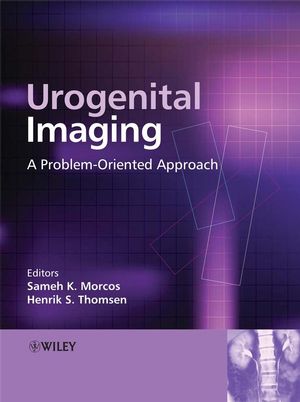Urogenital Imaging: A Problem-Oriented ApproachISBN: 978-0-470-51089-6
Hardcover
448 pages
March 2009
 |
||||||
Foreword xiii
Preface xv
Contributors xvii
1 Adrenal Imaging 1
Khaled M. Elsayes, Isaac R. Francis, Melvyn Korobkin and Gerard M. Doherty
1.1 Introduction 1
1.2 Cushing’s syndrome 2
1.3 Primary hyperaldosteronism 5
1.4 Pheochromocytoma 8
1.5 Adrenal cortical carcinoma 12
1.6 Adrenal incidentaloma 15
2 Retroperitoneal Masses 21
Pietro Pavlica, Massimo Valentino and Libero Barozzi
2.1 Introduction 21
2.2 Retroperitoneal anatomy 21
2.3 Pathological conditions 22
2.4 Primary solid retroperitoneal tumors 22
2.5 Retroperitoneal lymphoma 27
2.6 Cystic retroperitoneal masses 30
2.7 Retroperitoneal metastases 32
2.8 Retroperitoneal fibrosis (Ormond’s disease) 33
2.9 Retroperitoneal fluid collections (traumatic and non-traumatic) 35
References 41
3 Imaging of Renal Artery Stenosis 43
Robert Hartman
3.1 Introduction 43
3.2 Clinical features 43
3.3 Pathology 45
3.4 Imaging of suspected renal artery stenosis 45
References 51
4 Renal Masses 53
Philip J. Kenney
4.1 Introduction 53
4.2 Symptomatic renal carcinoma 53
4.3 Incidental renal masses 55
4.4 Patients with a known cancer (other than RCC) 62
4.5 Renal mass in patients with symptoms 63
4.6 Vascular lesions presenting as a renal mass 68
4.7 Renal mass in patients with cystic disease 72
4.8 Treatment 73
References 73
5 Non-neoplastic Renal Cystic Lesions 75
Sameh K. Morcos
5.1 Introduction 75
5.2 Classification 75
5.3 Cystic lesions affecting renal cortex 76
5.4 Cystic lesions of renal medulla 80
5.5 Cystic diseases affecting both the cortex and medulla 86
References 97
6 Urological and Vascular Complications Post-renal Transplantation 99
Tarek El-Diasty and Yasser Osman
6.1 Introduction 99
6.2 Vascular complications 99
6.3 Urological complications 107
6.4 Ureteric strictures 110
6.5 Post-transplant lymphocele 113
6.6 Delayed graft function (DGF) 116
6.7 Post-transplant bladder malignancy 119
References 120
7 Urinary Tract Injuries 121
Elliott R. Friedman, Stanford M. Goldman and Tung Shu
7.1 Introduction 121
7.2 Renal trauma 121
7.3 Adrenal trauma 130
7.4 Ureteral trauma 131
7.5 Bladder trauma 133
7.6 Urethral trauma 136
7.7 Penile and scrotal trauma 142
References 147
8 Urinary Tract Infections 149
Mikael Hellström, Ulf Jodal, Rune Sixt and Eira Stokland
8.1 Symptomatic urinary tract infection in children 149
8.2 Symptomatic upper urinary tract infection in adults 167
8.3 Emphysematous pyelonephritis 173
8.4 Xanthogranulomatous pyelonephritis 174
8.5 Urinary tract infection in the immunocompromised patient 177
8.6 Tuberculosis 179
8.7 Schistosomiasis 183
8.8 Hydatid disease (echinococcosis) 188
8.9 Urethritis 191
References 193
9 Imaging of the Genitourinary System – Urolithiasis 195
Sami A Moussa and Paramananthan Mariappan
9.1 Introduction 195
9.2 Pathology 195
9.3 Clinical features 197
9.4 Evaluation of patients with suspected urinary stones 198
9.5 Treatment 198
9.6 Imaging 199
References 218
10 Hematuria 219
Thomas Bretlau, Kirstine L. Hermann, Jørgen Nordling and Henrik S. Thomsen
10.1 Definition 219
10.2 Clinical considerations 219
10.3 Diagnosis of hematuria 220
10.4 Epidemiology 220
10.5 Distribution of malignancy in patients with hematuria 223
10.6 Imaging 223
10.7 Summary 230
References 234
11 Bladder Cancer 235
G. Heinz-Peer and C. Kratzik
11.1 Introduction 235
11.2 Clinical features 237
11.3 Pathology 239
11.4 Imaging findings 243
11.5 Treatment planning 253
11.6 Post-treatment Imaging 254
11.7 Summary 254
References 255
12 Imaging of Urinary Diversion 257
Sameh Hanna and Hesham Badawy
12.1 Introduction 257
12.2 Indications for urinary diversion 257
12.3 Types of urinary diversion 257
12.4 Non-continent cutaneous form of diversion 258
12.5 Continent cutaneous urinary diversion (Continent Catheterizing Pouches) 258
12.6 Non-orthotopic continent diversion, relying on the anal sphincter for continence 260
12.7 Orthotopic form of diversion to the native, intact urethra (neobladder) 261
12.8 Contraindications to urinary diversion 264
12.9 Complications of urinary diversions 264
12.10 The role of radiologist in urinary diversion includes 267
12.11 Imaging studies 268
12.12 Imaging of complications 269
12.13 Summary 271
References 271
13 Imaging of the Prostate Gland 273
François Cornud
13.1 Introduction 273
13.2 Zonal anatomy and benign prostatic hypertrophy 273
13.3 Diagnosis of prostate cancer: TRUS features 276
13.4 Diagnostic of prostate cancer: MRI 284
13.5 Contrast-enhanced (dynamic) MRI 285
13.6 Magnetic Resonance Spectroscopic Imaging (MRSI) 290
13.7 Diffusion-weighted imaging 292
13.8 Indications of functional MRI 295
13.9 Extension of prostate cancer 297
13.10 Local extension by TRUS and TRUS-guided biopsy 297
13.11 MRI and staging of prostate cancer 298
13.12 Local staging 299
13.13 Lymph node metastases: lympho-MRI 304
13.14 Bone metastases: whole marrow MRI 304
13.15 Benign disorders of the prostate (BPH excluded) 305
References 321
14 Haemospermia 323
Drew A. Torigian, Keith N. Van Arsdalen and Parvati Ramchandani
14.1 Introduction 323
14.2 Clinical features 323
14.3 Pathology 325
14.4 Imaging findings 325
14.5 Summary 337
References 337
15 Scrotal Masses 339
Lorenzo E. Derchi and Alchiede Simonato
15.1 Introduction 339
15.2 Clinical features 339
15.3 Pathology 340
15.4 Imaging 340
15.5 Important principles in assessment of scrotal masses 341
15.6 Important problems in differentiating benign from malignant lesions 345
References 350
16 Gynaecological Adnexal Masses 351
John A. Spencer and Michael J. Weston
16.1 Introduction 351
16.2 Clinical features 351
16.3 Pathology 352
16.4 Imaging 354
16.5 Standard radiographic techniques 355
16.6 Ultrasound (US) 355
16.7 MR Imaging (MRI) 366
16.8 Computed Tomography 373
References 379
17 Imaging of Abnormal Uterine Bleeding 381
Patricia Noël, Evis Sala and Caroline Reinhold
17.1 Abnormal uterine bleeding 381
17.2 Adenomyosis 382
17.3 Leiomyomas 385
17.4 Endometrial polyp 389
17.5 Endometrial hyperplasia 391
17.6 Endometrial carcinoma 394
17.7 Summary 396
References 397
18 Female Pelvic Floor Dysfunction 399
Rania Farouk El Sayed
18.1 Introduction 399
18.2 Anatomical considerations 399
18.3 Pathophysiology of pelvic floor dysfunction 401
18.4 Clinical features 401
18.5 Imaging of pelvic floor dysfunction 404
18.6 Magnetic resonance imaging (MRI) 407
References 413
19 Imaging of female infertility 415
Ahmed-Emad Mahfouz and Hanan Sherif
19.1 Introduction 415
19.2 Polycystic ovary syndrome 415
19.3 Abnormalities of the fallopian tubes (Hydrosalpinx/Hematosalpinx, tubal block) 418
19.4 Fibroids 421
19.5 Adenomyosis 423
19.6 Developmental anomalies of the uterus 424
19.7 Endometriosis 429
19.8 Imaging 430
Index 431



